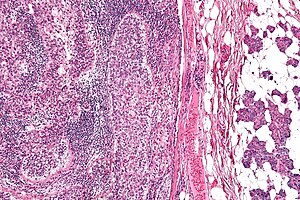Sebaceous carcinoma
| Sebaceous carcinoma | |
|---|---|
 |
|
| Micrograph of a sebaceous carcinoma (left of image) metastatic to the parotid gland (right of image). H&E stain. | |
| Classification and external resources | |
| Specialty | oncology, dermatology |
| ICD-10 | C44 (ILDS C44.L46) |
| eMedicine | article/1101433 |
Sebaceous carcinoma is an uncommon and aggressive malignant cutaneous tumor. Most are typically about 10 mm in size at presentation. This neoplasm is thought to arise from sebaceous glands in the skin and, therefore, may originate anywhere in the body where these glands are found. Because the periocular region is rich in this type of gland, this region is a common site of origin. The cause of these lesions are, in the vast majority of cases, unknown. Occasional cases may be associated with Muir-Torre syndrome.
This type of cancer usually has a poor prognosis because of a high rate of metastasis.
The cell of origin is usually unknown. Sebaceous gland carcinoma clearly resembles normal sebaceous glands and is thought to arise from them.
Well-differentiated and moderately differentiated sebaceous carcinoma tend to exhibit vacuolization within the cytoplasm of the tumor cells. Histology may mimic basal cell carcinoma.
This type of carcinoma is commonly managed by local resection, cryotherapy, topical chemotherapy, and radiotherapy. Multimodal therapy has been shown to improve both visual prognosis and survival.
Mohs micrographic surgery has become the treatment of choice for this form of cancer. When used as the primary treatment modality for sebaceous carcinoma of the eyelid, Mohs surgery is associated with significantly lower local and distant recurrence rates.
...
Wikipedia
